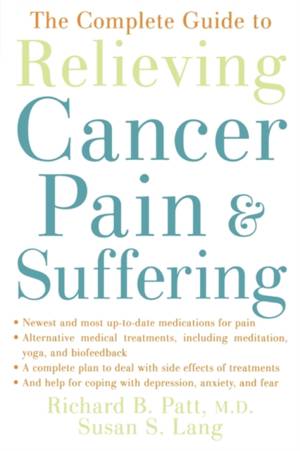
- Afhalen na 1 uur in een winkel met voorraad
- Gratis thuislevering in België vanaf € 30
- Ruim aanbod met 7 miljoen producten
- Afhalen na 1 uur in een winkel met voorraad
- Gratis thuislevering in België vanaf € 30
- Ruim aanbod met 7 miljoen producten
Zoeken
The Complete Guide to Relieving Cancer Pain and Suffering
Richard B Patt, Susan S Lang
Paperback | Engels
€ 69,45
+ 138 punten
Omschrijving
Most cancer patients fear unremitting pain more than the prospect of an untimely death, and are surprised to learn that most of the pain and related symptoms of cancer can be successfully addressed by an informed patient working with a determined health care team.
Thoroughly updating their widely praised 1994 book, You Don't Have to Suffer, Dr. Richard B. Patt and Susan Lang offer a much-needed handbook for patients and caregivers on all aspects of cancer pain and suffering. The authors identify the reasons why patients are so often under-medicated--from patients who feel the need to tough it out to doctors buried in time-consuming paperwork--and argue that properly medicated patients are better able to resume active lives and marshal strength to fight their disease. Those in chronic pain not only suffer, but also jeopardize their recovery. They demonstrate methods that can be used to cope with pain, nausea, constipation, fatigue, and other symptoms related to cancer and cancer treatment, and describe all of the pain-relieving options available in the modern medical arsenal. This includes drugs and high-tech medical procedures, as well as psychological, cognitive, and mind/body techniques. The authors also discuss depression and other psychological components that can contribute to suffering, as well as end-of-life issues. The book includes detailed charts of all the pain medications presently available and lists many available resources, from pain specialists to hospice and home care.
This book will empower cancer patients and their families to make informed decisions about their care and will be of enormous value to the growing number of patients, family members, and health-care professionals determined to relieve needless suffering.
Thoroughly updating their widely praised 1994 book, You Don't Have to Suffer, Dr. Richard B. Patt and Susan Lang offer a much-needed handbook for patients and caregivers on all aspects of cancer pain and suffering. The authors identify the reasons why patients are so often under-medicated--from patients who feel the need to tough it out to doctors buried in time-consuming paperwork--and argue that properly medicated patients are better able to resume active lives and marshal strength to fight their disease. Those in chronic pain not only suffer, but also jeopardize their recovery. They demonstrate methods that can be used to cope with pain, nausea, constipation, fatigue, and other symptoms related to cancer and cancer treatment, and describe all of the pain-relieving options available in the modern medical arsenal. This includes drugs and high-tech medical procedures, as well as psychological, cognitive, and mind/body techniques. The authors also discuss depression and other psychological components that can contribute to suffering, as well as end-of-life issues. The book includes detailed charts of all the pain medications presently available and lists many available resources, from pain specialists to hospice and home care.
This book will empower cancer patients and their families to make informed decisions about their care and will be of enormous value to the growing number of patients, family members, and health-care professionals determined to relieve needless suffering.
Specificaties
Betrokkenen
- Auteur(s):
- Uitgeverij:
Inhoud
- Aantal bladzijden:
- 464
- Taal:
- Engels
Eigenschappen
- Productcode (EAN):
- 9780195312027
- Verschijningsdatum:
- 4/12/2006
- Uitvoering:
- Paperback
- Formaat:
- Trade paperback (VS)
- Afmetingen:
- 142 mm x 249 mm
- Gewicht:
- 635 g

Alleen bij Standaard Boekhandel
+ 138 punten op je klantenkaart van Standaard Boekhandel
Beoordelingen
We publiceren alleen reviews die voldoen aan de voorwaarden voor reviews. Bekijk onze voorwaarden voor reviews.











